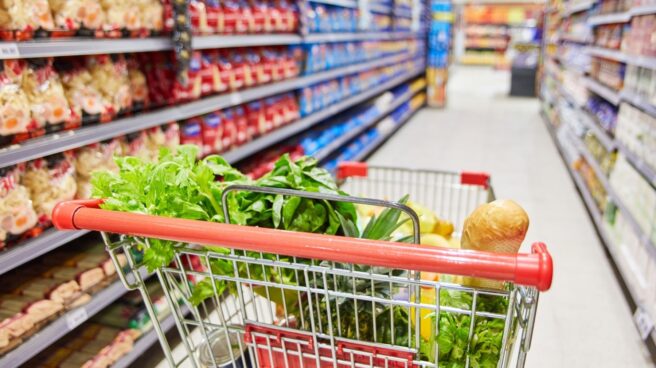

Basket

He food consumption dial red numbers. Inflation has reduced the amount of food we buy for home consumption. And the latest official statistics available (through August) show a cumulative fall of 3.5% over the past year.
Data from the Ministry of Agriculture, Fisheries and Food, which he currently heads. Luis Planas show a steady decline in many categories from September 2022 to August 2023. With particular force he falls from fishwith 941 million kilograms compared to 866.4 (-7.9%).
The table of the department managed by Planas, with categories and types of products, reflects the fact that at the end of last year we only bought more. eggs, chicken And sunflower oil.
Meat consumption declines by 0.7% and is maintained by rising demand for fresh chicken meat (5.8%) and frozen meat (5.9%). On the other hand, other types of meat with a higher average price such as bullish they fall by 7% of accumulated value over the last twelve months.
It comes out worse rabbit, which fell 18.1%, while lamb and goat fell a further 7.7%. The one who falls the least is the one pig, which lost just 1.1% compared to the same period last year. Demand for processed meat also fell another 2.5%.
This higher average protein price may be partially offset by increased purchases eggs, which increased by 6.2% in accumulated. This is despite the fact that its price has increased by 16.1% during this time, the report says.
Another obvious transfer effect is observed in the oil sector. Purchase olive oil over the past year fell by 9.6%, while demand for sunflower oil increased by 8.7%. The average drop in the category is 5.1%. It is one of the products whose prices have risen the most over the past year due to the severe drought, which has reduced the cost of the campaign to half what it normally would have been.
Within the fishing sector category fish fell by 5.9% over the last twelve months, and by 12.9% for shellfish, molluscs and crustaceans. Likewise, canned fish and shellfish yielded 6.5%.
On the other hand, one of the goods that has risen in price the most over the past year is milk- its consumption is also reduced. In particular, purchases of milk and dairy products decreased by 4.3%. Cheeses resisted a slight rise of 1.9%, while yoghurts showed a downward trend; especially those containing bifidos, the amount of which drops sharply by 12%.
Households stopped purchasing 4.4% of liquid milk, especially skimmed (8.0%) and semi-skimmed (4.1%), while purchases of whole milk decreased by 0.9% compared to the previous rolling year.
Purchase Fresh fruits It also fell by 5.5%, fresh vegetables – by 4.9%. Fresh potatoes are consumed 1.9% less (1.9%), with particular declines observed in oranges (-14.6%) and watermelons (-8.2%), two of which saw the largest price increases.
Other types of food are also falling, e.g. bread (2%), flour And semolina (7%), rice (3.6%), legumes (4.9%) and pasta (0.8%). On the beverage side, soft drinks and soft drinks fell 3%; alcoholic drinks – 3.4%; wine – 7.9%; beer – 4.5%; and ciders fell by 17.4%.
More white label
In addition to this reduction in consumption, shoppers have also adapted their supermarket shopping habits, placing an increasing emphasis on private label products over manufacturer branded products.
In fact, Spain is already one of the eurozone countries where so-called “white labels” have the greatest weight – more than 43% of the total. So it’s put in front Great Britain And Germany, markets where it has traditionally had a very strong weight. As Javier Campo, president of the association of manufacturers and distributors, explained last week. Aekokthis trend should begin to soften.
In parallel, businessmen suggest that the final period of the year will be marked by increased advertising pressure in order to stimulate consumption without a structural fall in prices. 78% of companies surveyed on the occasion of the 38th Congress, held in Zaragoza, expect an increase in advertising activity in the coming months, and 54% believe that there will be more offers than in the last campaign.
VAT reduction
Consumer managers meeting in Zaragoza said the loss of purchasing power in the current inflationary context was a major concern for companies. They asked the government to finally take measures aimed at preserving purchasing power and stimulating consumption. Among them is maintaining VAT reduction to main products.
In particular, consumer organization Facua monitored the prices of 1,000 food products affected by the VAT cut in eight major retail chains and concluded that 52.4% of the products analyzed had already increased their prices compared to what they were at the beginning of the year. year of application of the standard.
Of the 505 prices where an increase was recorded, 153 were for fruits and vegetables (30.2% of the total), 103 for olive oil (20.3%) and 73 for milk and dairy products (14.4%). Also recorded were 72 price increases for rice and pasta (14.2%) and 47 for legumes (9.3%). The remaining 57 increases correspond to eggs, flour and bread.
Source: El Independiente